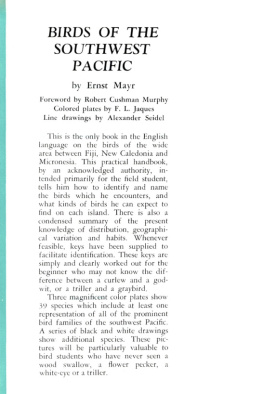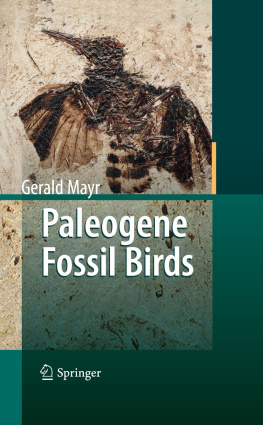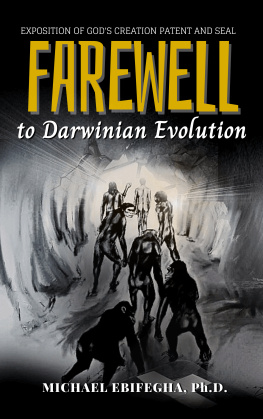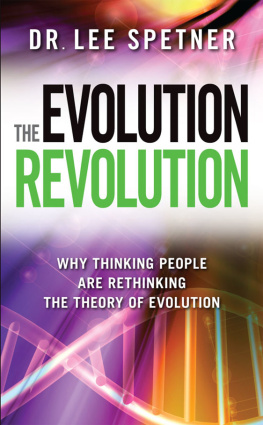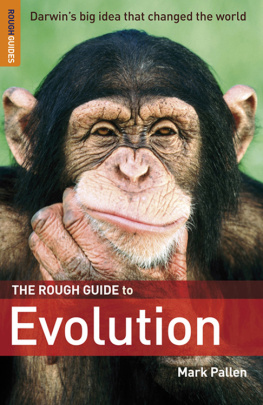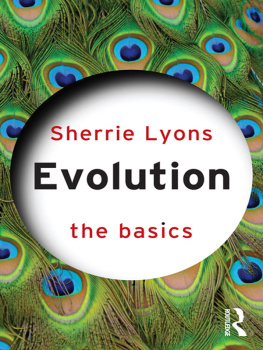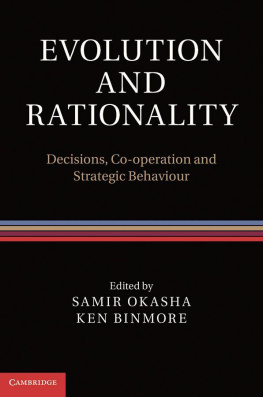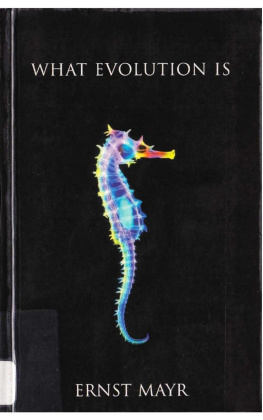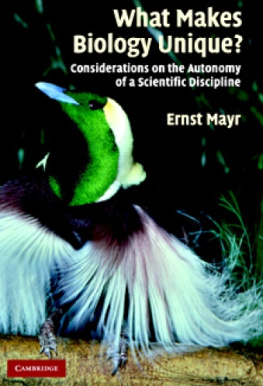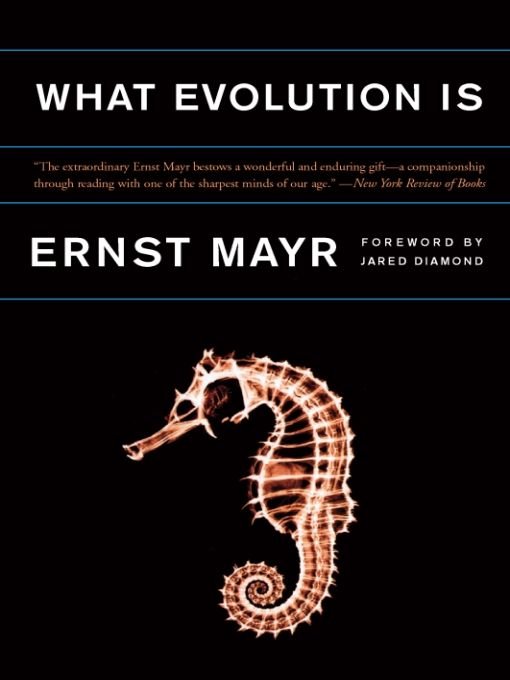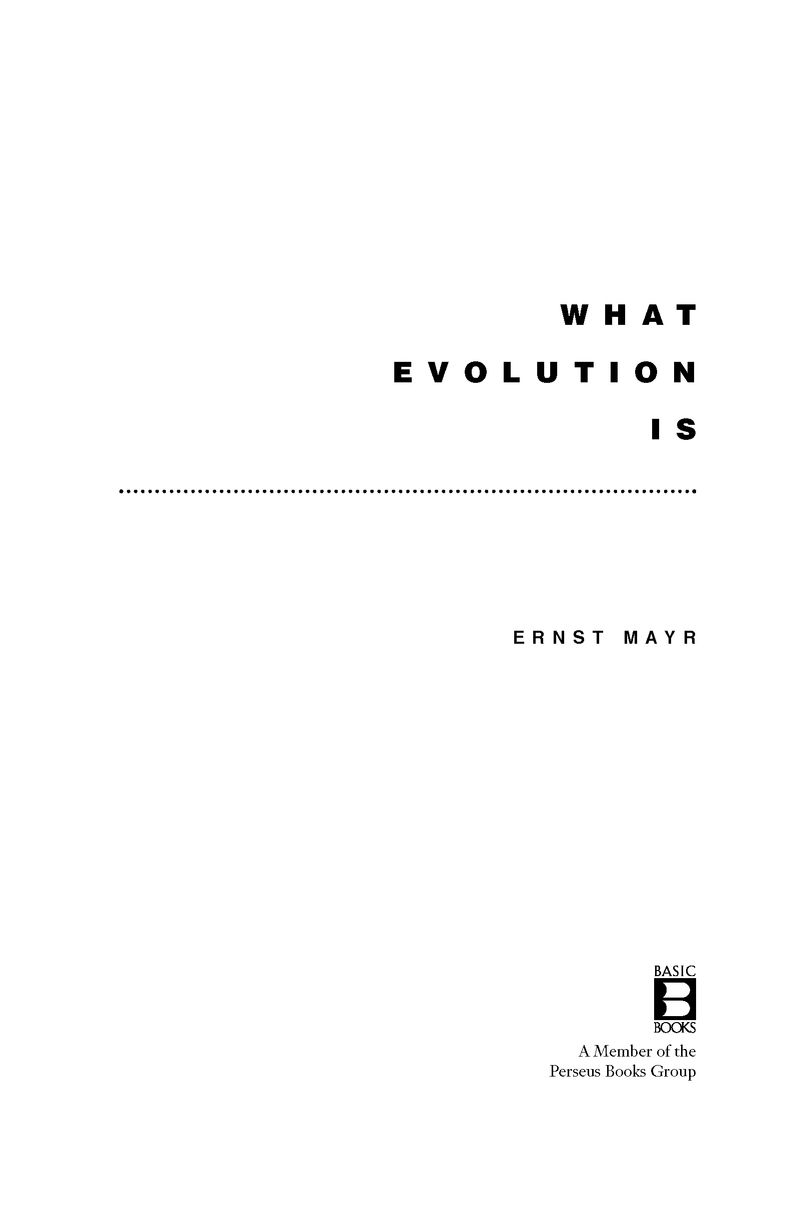Table of Contents
Also by Ernst Mayr
This Is Biology (1997)
One Long Argument (1991)
Principles of Systematic Zoology (1990, with Peter Ashlock)
Toward a New Philosophy of Biology (1988)
The Growth of Biological Thought (1982)
The Evolutionary Synthesis (1980, with W. Provine)
Evolution and the Diversity of Life (1976)
Populations, Species, and Evolution (1970)
Principles of Systematic Zoology (1969)
Animal Species and Evolution (1963)
Methods and Principles of Systematic Zoology
(1953, with E. G. Linsley and R. L. Usinger)Birds of the Philippines (1946, with Jean Delacour)
Birds of the Southwest Pacific (1945)
Systematics and the Origin of Species (1942)
To the naturalists from Aristotle to the present,
who have taught us so much about the living world.
FOREWORD
Evolution is the most profound and powerful idea to have been conceived in the last two centuries. It was first developed in detail with the 1859 publication of the book On the Origin of Species, by Charles Darwin, who enjoyed a long and incredibly productive life. While Darwins professional career began with a round-the-world biological collecting trip on which he embarked at the age of 22 aboard the HMS Beagle, he had already been devoted to outdoor natural history as a boy.
A great deal new has been learned about the workings of evolution since Darwins day. Wouldnt it be wonderful if Darwin himself, a clear and forceful writer as well as the greatest biologist of his generation, could write for us a new book on the status of evolutionary thought today! Of course thats impossible, because Darwin died in 1882. This book is the next best: it has been written by a man who is one of the greatest biologists of our own day, who has also enjoyed a long and incredibly productive life, and who is also a clear and forceful writer.
To place Ernst Mayr in perspective, Ill relate an experience of my own. In 1990 I carried out the second bird survey of the Cyclops Mountains, a steep, high, isolated range rising from the north coast of the tropical island of New Guinea. The survey proved to be difficult and dangerous, because of the daily risks of falling off the steep slippery trails, of getting lost in the dense jungle, of exposure in cold wet conditions, and of potential conflicts with local people on whom I depended but who had their own agendas. Fortunately, New Guinea had by then been pacified for many years. Local tribes were no longer at war with each other, and European visitors were a familiar sight and were no longer at risk of being murdered. None of those advantages existed in 1928, when the first bird survey of the Cyclops Mountains was carried out. I found it hard to imagine how anyone could have survived the difficulties of that first survey of 1928, considering the already-severe difficulties of my second survey in 1990.
That 1928 survey was carried out by the then23-year-old Ernst Mayr, who had just pulled off the remarkable achievement of completing his Ph.D. thesis in zoology while simultaneously completing his pre-clinical studies at medical school. Like Darwin, Ernst had been passionately devoted to outdoor natural history as a boy, and he had thereby come to the attention of Erwin Stresemann, a famous ornithologist at Berlins Zoological Museum. In 1928 Stresemann, together with ornithologists at the American Museum of Natural History in New York and at Lord Rothschilds Museum near London, came up with a bold scheme to clean up the outstanding remaining ornithological mysteries of New Guinea, by tracking down all of the perplexing birds of paradise known only from specimens collected by natives and not yet traced to their home grounds by European collectors. Ernst, who had never been outside Europe, was the person selected for this daunting research program.
Ernsts clean-up consisted of thorough bird surveys of New Guineas five most important north coastal mountains, a task whose difficulties are impossible to conceive today in these days when bird explorers and their field assistants are at least not at acute risk of being ambushed by the natives. Ernst managed to befriend the local tribes, was officially but incorrectly reported to have been killed by them, survived severe attacks of malaria and dengue and dysentery and other tropical diseases plus a forced descent down a waterfall and a near-drowning in an overturned canoe, succeeded in reaching the summits of all five mountains, and amassed large collections of birds with many new species and subspecies. Despite the thoroughness of his collections, they proved to contain not a single one of the mysterious missing birds of paradise. That astonishing negative discovery provided Stresemann with the decisive clue to the mysterys solution: all of those missing birds were hybrids between known species of birds of paradise, hence their rarity.
From New Guinea, Ernst went on to the Solomon Islands in the Southwest Pacific, where as a member of the Whitney South Sea Expedition he participated in bird surveys of several islands, including the notorious Malaita (even more dangerous in those days than was New Guinea). A telegram then invited him to come in 1930 to the American Museum of Natural History in New York to identify the tens of thousands of bird specimens collected by the Whitney Expedition on dozens of Pacific Islands. Just as Darwins explorations, sitting at home, of collections of barnacles were as important to Darwin in forming his insights as was his visit to the Galapagos Islands, so too Ernst Mayrs explorations of bird specimens in museums were as important as his fieldwork in New Guinea and the Solomons in forming his own insights into geographic variation and evolution. In 1953 Ernst moved from New York to Harvard Universitys Museum of Comparative Zoology, where even today he continues to work at the age of 97, still writing a new book every year or two. For scholars studying evolution and the history and philosophy of biology, Ernsts hundreds of technical articles and dozens of technical books have been for a long time the standard reference works.
But in addition to gaining insights from his own fieldwork in the Pacific and from his own studies of museum bird specimens, Ernst has collaborated with many other scientists to extract insights from other species, ranging from flies and flowering plants to snails and people. One of those collaborations transformed my own life, just as the meeting with Erwin Stresemann transformed Ernsts life. While I was a teenaged schoolboy, my father, a physician studying human blood groups, collaborated with Ernst in the first study proving that human blood groups evolve subject to natural selection. I thereby met Ernst at dinner at my parents house, was later instructed by him in the identification of Pacific island birds, began in 1964 the first of 19 ornithological expeditions of my own to New Guinea and the Solomons, and in 1971 began to collaborate with Ernst on a massive book about Solomon and Bismarck birds that we completed only this year, after 30 years of work. My career, like that of so many other scientists today, thus exemplifies how Ernst Mayr has shaped the lives of 20th-century scientists: through his ideas, his writings, his collaborations, his example, his lifelong warm friendships, and his encouragement.
Yet evolution needs to be understood not only by scientists, but also by the general public. Without understanding at least something of evolution, one has no chance of understanding the living world around us, human uniqueness, genetic diseases and their possible cures, and genetically engineered crops and their possible dangers. No other aspect of the living world is as fascinating and full of riddles as is evolution. How can one explain the remarkable adaptation of every species to its chosen niche? Or the beauty of birds of paradise, butterflies, and flowers? How can one explain the gradual advance from the simplest bacteria three-and-a-half billion years ago to dinosaurs, whales, orchids, and giant sequoias? Natural theologians had raised such questions for hundreds of years, but were unable to find any other answer than the hand of a wise and almighty creator. Eventually, Darwin argued that the fascinating world of life had gradually evolved by natural processes from the simplest kinds of bacteria-like organisms, and he backed up his claim by presenting a well-thought-out theory of evolution. Most importantly, he also proposed a theory of causation, the theory of natural selection.


